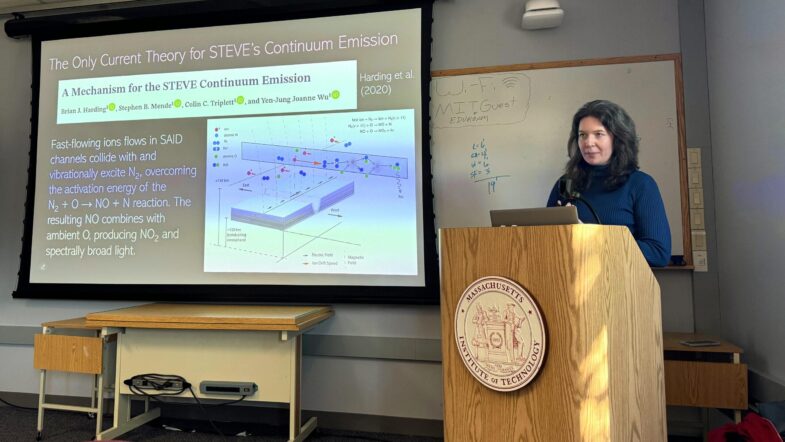
Berkeley scientist, Haystack REU alumna L. Claire Gasque visits Haystack
University of California–Berkeley research scientist, co-founder of Berkeley SSL’s REU program, and former REU student intern Dr. L. Claire Gasque returned to Haystack this October to present her latest research and have collaborative discussions with colleagues in the Haystack atmospheric and geospace science group. Gasque delivered a talk on auroral phenomena in the group’s conference room, noting that it was the same spot where she gave her very first science talk at the end of her REU internship.

As a talented Dartmouth College undergraduate, Gasque received acceptances to multiple REU programs; Haystack was fortunate that she decided to work here on Millstone Hill radar plasma-line analysis. While attending the 2018 Haystack REU program, Gasque presented not one but two projects completed that summer: a talk on her Millstone Hill Plasma Line Full Profile Project and a poster on a Comparison of Millstone Hill Plasma Line and Lowell Digisonde Plasma Frequencies: A Statistical Study. The Haystack REU presentation archives are available online.
“I wouldn’t trade my experience at Haystack for anything. It’s put me on a trajectory that has really set up my whole career—I don’t think I’d be where I am today without it. I come from a family of journalists and artists, none of whom have a PhD, so I was really carving my own path,” says Gasque, who worked with mentors Phil Erickson (now Haystack director), Bill Rideout, and Shunrong Zhang. “I vividly remember feeling like I was witnessing real, cutting-edge science happening in real time. I felt awed by it!”
Director Erickson said, “The Haystack REU program over its nearly 40-year history has produced a number of scientists and engineers in the fields Haystack researchers study. Claire Gasque was an exceptional student here in 2018 during our summer program, and her experience forged a decision to pursue a career in geospace research, leading to her position now as a research scientist at UC Berkeley’s Space Science Laboratory. Her visit was a great reminder that the initial connections generated by student programs can blossom years later into long-lasting professional connections for everyone’s benefit in frontier studies of the near-Earth space environment.”

After graduating from Dartmouth, Gasque started her work toward a doctorate at UC Berkeley’s Physics Department, in the Space Sciences Lab (SSL). She first worked with the Parker Solar Probe team there, but soon returned to her ionospheric “roots,” joining the ICON satellite team to study ionosphere-thermosphere coupling. She has since attended international conferences, published numerous papers, and been featured in Science News, the Washington Post, and the BBC.
As a graduate student, Gasque collaborated with PIs Matt Fillingim and Trevor Bowen on a successful proposal to restart the ASSURE REU program during the pandemic. This SSL program mainly targets California community college students, many of whom have never done research before. Gasque helped coordinate the program over the past four years, from advertising and reviewing applications to running their bootcamp, which teaches coding, research skills, and space science fundamentals. “It’s been incredibly rewarding to see students who hadn’t considered research or grad school leave with new career aspirations,” she said. “I’ve also mentored a Berkeley undergraduate, Mateo, who I encouraged to apply to the Haystack REU. They were thrilled to be accepted and worked with some of the same mentors I had! Mateo hadn’t considered a research career, but now they’re thinking about grad school too—and even joked about establishing a Haystack REU legacy. Maybe their student will attend the Haystack REU too someday—who knows!”
Gasque was awarded her PhD degree in May 2024 and is now an Assistant Researcher at SSL. Her research focuses on thermosphere-ionosphere coupling, exploring both equatorial and auroral phenomena, including a project that stems directly from her REU work on solar terminator waves using the ionospheric radars at Haystack, later finding in the ICON satellite data a particularly strong signal in the thermospheric winds.
At her recent Haystack seminar, Gasque focused on her work with STEVE and the “picket fence,” two mysterious aurora-like glows in the subauroral ionosphere that resemble auroras but are caused by different processes. Her current research includes deciphering the atmospheric chemistry behind these emissions to better understand the physics that causes them. The entire Haystack geospace group was pleased to welcome Gasque and looks forward to additional future collaborations.